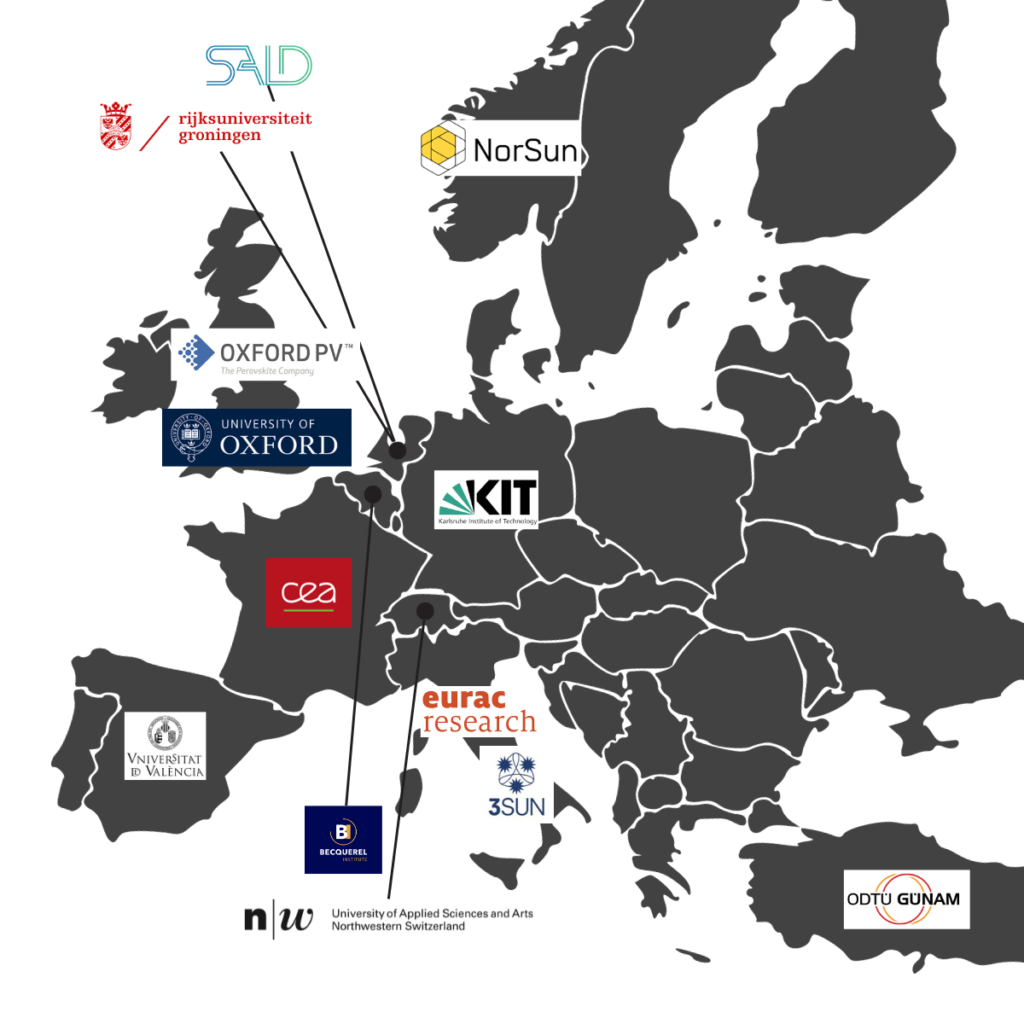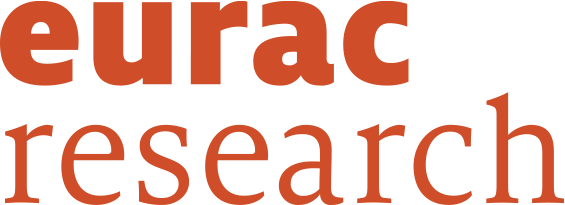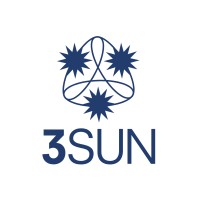About the Project
NEXUS
NEXUS is a 3-year research and innovation project funded by the European Commission through HORIZON EUROPE Research and Innovation Actions.
NEXUS’s aim is to develop stable, 2-terminal perovskite-Si tandem solar cells with power conversion efficiencies above 33% (and modules > 30%) following an innovative eco-design approach: employing solvent-free perovskite deposition, abundant and optimized use of materials, circularity, recyclability, improved and simple manufacturing processes, to create a viable economic pathway for the European commercialization of this sustainable technology.
Objectives
- Develop perovskite absorbers with bandgaps, stable towards light, heat, humidity, and electric fields, via solvent-free sustainable, industrially relevant methodologies.
- Develop technologies for the manufacturing of PVSK/Si tandem devices with a low environmental impact.
- Develop perovskite top cells.
- Deliver tandem modules with power conversion efficiency >30% and establish the Bill of Materials for different applications.
- Demonstrate scalability and proof-of-concept equipment sets for each processing step in the production.
- Test outdoor durability of the tandem modules and draft a bankability report.
- Quantify the economic, environmental, and social impact of the sustainable tandem technology, provide proof of the principle of circularity and guide the RTD activities in NEXUS towards maximizing sustainability.
NEXUS
Consortium Members

This consortium involves 13 partners from 10 countries who will be collaborating and bringing their expertise to achieve the best results for this project.
Commissariat à l'Energie Atomique et aux Energies Alternatives (CEA)
Created in 1945, the French Alternative Energies and Atomic Energy Commission (CEA) is a key player in research, tasked with guiding public decisions and providing the scientific and technical means that civil society (businesses and local authorities) needs to better manage major societal changes, such as the energy transition, digital transformation, future healthcare, defence and global security. CEA's LITEN institute is a CEA technological research institute specializing in energy transition technology. Its research activities focus on a number of key areas: solar power, network management, storage, including batteries, and hydrogen, geared to energy efficiency and a circular economy. Its research encompasses diverse applications in the energy generation and distribution markets, transport and industrial processes, and for the environment. On the campus of the National Institue for Solar Energy (INES) in Chambéry, CEA-LITEN’s research activities on PV technologies cover the entire value chain, from material to the complete system with a focus on the most promising technologies in terms of efficiency. CEA is the coordinator of NEXUS and, as such, leads the corresponding management work-package (WP7). In particular, CEA will ensure the Project Coordination at administrative level, including financial reporting and communication with the European Commission. At the technical level, CEA will take in charge the development of the silicon bottom cell, participate in the integration of the tandem devices including bottom cell, obviously, recombination junction and metallization. CEA will develop the module technology for the tandem devices, fabricate demonstrators and evaluate their reliability based on indoor intensive testing. Finally, CEA will participate in assessing the sustainability of NEXUS technology by taking part in the elaboration of a sustainable material selection guide and in the definition of a sustainability roadmap for perovskite tandems.

The Chancellor, Masters and Scholars of the University of Oxford
The University of Oxford is the world’s oldest English-speaking university, has been at the forefront of research, scholarship and innovation for over 850 years and is today a vibrant hub of internationally-leading work spanning all aspects of science, medicine, the social sciences and humanities. Our mission is the advancement of learning by teaching and research, and its dissemination by every means; and our goal is to make a difference at all scales, from the local to the global, influencing technology, policy and culture for the benefit of society. We aim to excel in every knowledge exchange and innovation mechanism to deliver these goals, including activities measured by the KEF metrics and beyond. Oxford is assuring the WP7 leadership, absorber development, single junction and tandem cell development and characterization. Stability enhancement. Supply of tandem cells for modulization.

Eurac Research
Eurac Research was founded in 1992 as an association under private law with just twelve members of staff undertaking research in the areas of Language and Law, Minorities and Autonomous Regions as well as the Alpine Environment. The center gradually expanded its activities into new areas, attracted scientists from all over the world, and introduced new structures. Today, over 500 collaborators from over 35 countries conduct their research at Eurac Research. Our research addresses the greatest challenges of the future: keeping societies healthy, fostering intact environments, promoting sustainable energy and developing well-functioning political and social systems. Seeking answers through interaction between a variety of disciplines, we develop concrete solutions for regional problems which can then be applied globally. We continually strive to open new paths with science and innovation, by responding to society’s complex questions with answers geared to the needs of people. Eurac Research is leading the work package on Reliability, Energy yield and Bankability. Additionally, we will analyse the sustainability of the develop Perovskite-Silicon technology by performing LCA analyses.
Karlsruher Institut für Technologie
Being “The Research University in the Helmholtz Association”, KIT creates and imparts knowledge for the society and the environment. It is the objective to make significant contributions to the global challenges in the fields of energy, mobility, and information. For this, about 9,800 employees cooperate in a broad range of disciplines in natural sciences, engineering sciences, economics, and the humanities and social sciences. KIT prepares its 22,300 students for responsible tasks in society, industry, and science by offering research-based study programs. Innovation efforts at KIT build a bridge between important scientific findings and their application for the benefit of society, economic prosperity, and the preservation of our natural basis of life. KIT is one of the German universities of excellence. The division "Next Generation Photovoltaics" led by Tenure-Track-Prof. Dr. Ulrich W. Paetzold researches and develops new processes, materials, and device architectures for perovskite-based tandem photovoltaics. The interdisciplinary team is engaged in several national and international research projects as well as industry collaborations. It is our ambition to advance the stability and scalability of perovskite-based photovoltaics and lift the power conversion efficiency of perovskite-based tandem solar cells above 33%. In NEXUS, KIT will be working on the development of new materials and processes for evaporated perovskite top solar cells and tandem solar cells. Optical simulations and energy yield modelling.

Rijksuniversiteit Groningen
Founded 23 August 1614, the Rijkuniversiteit Groningen is one of the oldest universities in Europe. It has a staff of 6400 FTE, of which 400 are professors, and 37000 students. Its research generates about 8500 research publications per year. The Zernike Institute for Advanced Materials is one of its most prominent research institutions, which aims to achieve international leadership in the design and understanding of novel functional materials. The Zernike Institute is one of the two Top Research Schools of the Netherlands and has been recently evaluated as “outstanding”. The role of RUG in the NEXUS project is to develop and use numerical modelling techniques to explain experimental device performance and to identify pathways to more efficient perovskite solar cells.

SALD B.V.
SALD is a spin-off from SoLayTec, which developed and sold advanced Spatial ALD machines for the mass production of solar panels, mainly to China. Therefore, SALD has in-depth expertise in Spatial ALD technology, combined with the unique ability to transfer it from lab to fab. To realize the great opportunities in today’s growth markets, SALD has developed a unique technology that makes this possible, which is protected by several patents. This technology has been incorporated into a compact machine that can be used for research as well as for small-scale production. Also, research programs have been started, in which SALD works closely with renowned research institutes. In NEXUS, SALD will be working on spatial-ALD development for single junction and tandem cell integration and modulization.

Universitat de València
The old "Estudi General de València", founded in 1499 and initially dedicated to the study of medicine, humanities, theology and law, has today become a modern European university, open to the culture of practically every branch of teaching. Currently, the University of Valencia stands out as one of the main public research organisations in Spain, with more than three thousand researchers integrated in 84 departments, 21 institutes and 5 other research units, belonging to social, biomedical, human, experimental and formal sciences. Along with human resources, the University of Valencia state-of-art premises and facilities, together with its instrumental equipment, both guarantee the quality of a vast scientific and technological offer available to the service of society. In NEXUS, Universitat de Valencia manages the WP1 Leadership, absorber and charge transporting materials evaluation in single junction and tandem cells and modules.

3 SUN
3Sun factory, founded in Catania in 2010, is set to become Europe’s largest factory producing high-performance bifacial photovoltaic modules. 3Sun Gigafactory combines research and innovation to produce new-generation photovoltaic modules that support the Enel Group in guaranteeing clean and renewable energy and building a more sustainable and environmentally-friendly world. 3Sun will be working on si sub cell fabrication, tandem cell integration and sustainability assessment, production assessment and industrialization guidance, exploitation.

Oxford Photovoltaics Limited
Oxford Photovoltaics is the pioneer and technology leader in the field of perovskite solar cells. We were established in 2010 as a spin-out from the University of Oxford. Today, we have the largest global team exclusively focused on developing and commercialising a perovskite-based solar technology, and we are building the world’s first volume manufacturing line for perovskite-on-silicon tandem solar cells. The role of Oxford PV in the NEXUS project is to provide industry-relevant feedback and generate assessments and evaluations regarding scale-up towards commercial scale production within the context of sustainable manufacturing.

Becquerel Institute
The Becquerel Institute was founded in 2014, it combines the strength of a consultancy company with a dedicated research activity focusing on the ecosystem of solar photovoltaics. Its expertise is three-fold: applied research, strategic consultancy, and technical assistance. In the NEXUS project, the Becquerel Institute is leading the communication, dissemination and exploitation work. The combination of the Becquerel's ties to national PV associations in various EU countries, APVIA in Asia, Solar Power Europe, Solar United, the European Solar Manufacturing Council ESMC and the ETIP-PV; its participation in various EU-funded projects; and its knowledge of the PV market and applications sector streghten the competences of this project. The Becquerel Institute will ensure the WP6 Leadership, Exploitation management and dissemination activities.

Norsun AS
NorSun is a Norwegian solar energy company that manufactures and markets high performance mono-crystalline silicon ingots and wafers for the global solar energy industry. Dedicated to high efficiency n-type wafers and sustainable production with low CO2 emissions, we are an established supplier to tier-one cell manufacturers. NorSun operates a modern production facility located in Årdal in western Norway, pursuing a detailed and aggressive technology development and cost road map which ensures a competitive price model. The NorSun plant is powered by low cost renewable hydropower, enabling very low emissions from production. In June 2019, the company closed a NOK 230 million equity round to increase the production capacity to 1 GW, introduce new technologies, and significantly reduce unit costs. NorSun will be working on the supply and modification of “green-silicon” wafers and the industrialization. guidance, exploitation.

Fachhochschule Nordwestschweiz
FHNW is one of Switzerland’s leading universities of applied sciences and arts, actively involved in teaching, research, continuing education and service provision – both innovative and practice-oriented. Based in Muttenz near Basel, the FHNW School of Life Sciences is part of Europe’s largest life sciences centre and lies at the heart of pharmaceutical and medical technology, the chemical industry and environmental and biotechnology. The Institute for Ecopreneurship conducts research into fields of applied environmental science. We analyse current ecological challenges and research measures to preserve and improve the quality of the environment. As part of this, we develop and test technical solutions for reducing emissions and recycling resources. We devise concepts and optimise processes for resource-efficient production. We also evaluate the environmental compatibility of substances and processes with methods from the field of ecotoxicology and life cycle analysis. FHNW leads the work package on resource efficiency and sustainability. The FHNW also conducts life-cycle assessments, develops recycling schemes, and ensures the safe deployment of tandem perovskites through outdoor leaching tests.

ODTU GUNES ENERJISI UYGULAMA VE ARA STIRMA MERKEZI
ODTÜ-GÜNAM was founded by an initiative from the Middle East Technical University (ODTÜ/METU). It is not a coincidence that this establishment has come out from METU, where the solar energy studies date back to the 80s. ODTÜ-GÜNAM has been supported by the Ministry of Development (Turkey) since its establishment at the beginning of 2009. ODTÜ-GÜNAM infrastructure has been built up in the great campus area of Middle East Technical University as a multi-discipliner research center. The faculty members from the seven different disciplines of three different faculties have contributed to the establishment and development of ODTÜ-GÜNAM: METU Physics and Chemistry Departments (Faculty of Arts and Sciences); METU Civil Engineering, Electrical & Electronics Engineering, Materials & Metallurgy Engineering, and Mechanical Engineering Departments (Faculty of Engineering); Architecture Department (Faculty of Architecture). This wide range of participation reflects the center’s multidisciplinary nature, which is necessary for this technology.

The Project
Next Generation of Sustainable Perovskite-Silicon Tandem Cells (NEXUS) is a 3-year research and innovation project funded by the European Commission through HORIZON EUROPE Research and Innovation Actions.
Grant Agreement: n°101075330








